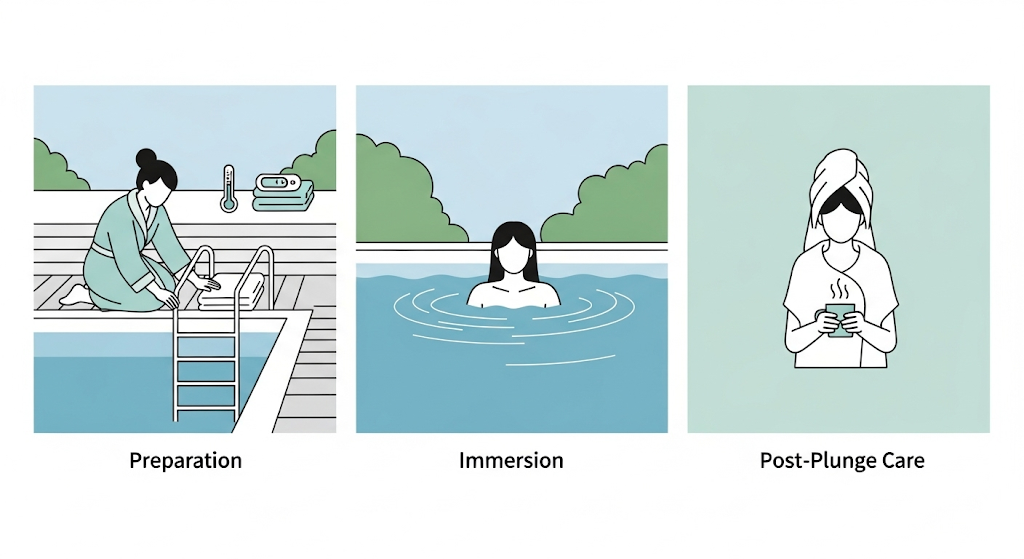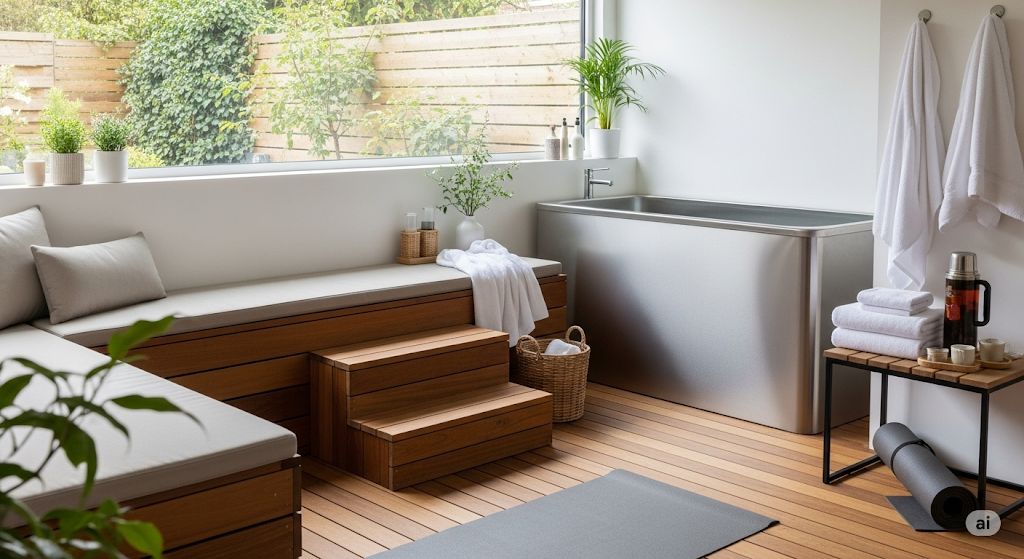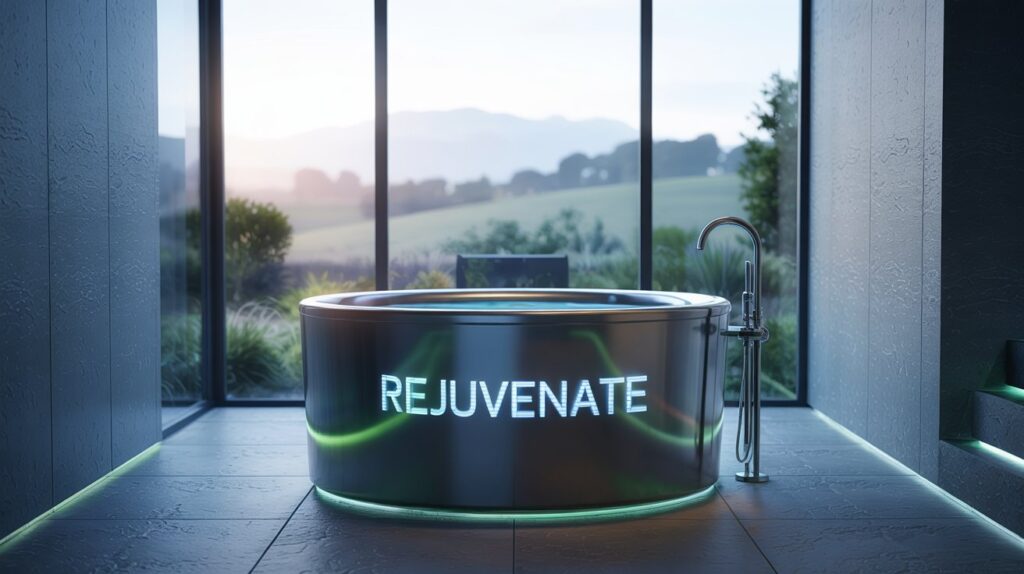Ready to explore a unique path to enhanced well-being? Imagine stepping into refreshingly cold water, feeling an invigorating rush that awakens your senses and body. This isn’t just a quick dip; it’s cold plunge therapy, a practice rapidly gaining recognition for its profound health benefits. But what exactly is it, and why are more people embracing the chill?
Let’s dive into the science and practicalities behind this increasingly popular trend.
What is Cold Plunge Therapy?
Cold plunge therapy, also known as cold water immersion or cold therapy, involves deliberately submerging your body in cold water (typically 10-15°C or 50-59°F) for a short period.
This form of hydrotherapy has roots in ancient civilizations, where cultures like the Greeks and Romans recognized the rejuvenating power of cold water.
Throughout history, cold immersion has been used to boost circulation, reduce inflammation, and invigorate both mind and body.
Today, cold plunges are celebrated for their potential to accelerate recovery, elevate mood, and improve overall physical and mental resilience.
The Science Behind the Chill
When you expose your body to cold water, several physiological responses occur:
- Vascular Constriction and Dilation: Your blood vessels constrict in the cold, then dilate as you warm up. This “pumping” action can improve circulation, potentially benefiting cardiovascular health.
- Brown Adipose Tissue Activation: Cold exposure activates brown adipose tissue (BAT), a type of fat that generates heat by burning calories. This can subtly boost your metabolic rate.
- Inflammatory Response Modulation: Cold helps to constrict blood vessels, which can reduce swelling and inflammation, making it beneficial for muscle recovery and pain relief.
- Hormonal and Neurotransmitter Release: The “cold shock” triggers the release of endorphins and norepinephrine, natural mood elevators and pain reducers, contributing to improved mood and reduced perceived soreness.
Transformative Benefits of Cold Plunge Therapy
Cold plunge therapy offers a diverse range of advantages for both your physical and mental health, appealing to everyone from athletes seeking an edge to individuals looking for a natural mood booster.
Physical Health Boosts
Regular cold plunges can significantly enhance your physical well-being:
- Accelerated Muscle Recovery: By reducing inflammation and muscle soreness (delayed onset muscle soreness or DOMS), cold plunges help you recover faster after intense workouts, promoting quicker return to training.
- Enhanced Blood Circulation: The constriction and dilation of blood vessels can improve overall blood flow, delivering oxygen and nutrients more efficiently throughout your body.
- Strengthened Immune Response: Consistent cold exposure has been linked to a stronger immune system, potentially increasing your body’s resilience against illness.
- Metabolic Support: Activation of brown fat can contribute to a healthier metabolic rate.
Mental and Emotional Well-being
Beyond the physical, cold plunges offer profound mental benefits:
- Mood Elevation: The release of endorphins and norepinephrine provides a natural mood lift, helping to reduce symptoms of anxiety and depression. Many users report feeling more alert and energized.
- Increased Resilience to Stress: Regular exposure to controlled stress (like cold) can help your body and mind adapt, improving your ability to cope with everyday stressors.
- Improved Focus and Alertness: The invigorating shock of cold water can clear your mind and enhance mental clarity.
Peak Performance and Recovery for Athletes
Athletes have long embraced cold therapy for a reason. Incorporating cold plunges into a training regimen can:
- Minimize DOMS: Drastically reduce post-exercise muscle soreness.
- Speed Up Recovery: Facilitate faster recovery times between training sessions and competitions.
- Reduce Inflammation and Muscle Damage: Help mitigate the inflammatory response after strenuous activity.
- Enhance Overall Performance: By promoting quicker recovery and reducing fatigue, athletes can train harder and more consistently.
Your Cold Plunge Journey: From Preparation to Post-Plunge Care

Starting out on cold plunge therapy requires a structured approach to ensure safety and maximize benefits.
Preparing for Your Plunge
Gradual acclimatization is key, especially for beginners.
- Start Small: Begin by ending your warm showers with 30-60 seconds of cold water.
- Gradual Exposure: Slowly increase your exposure to cooler temperatures over time. This helps your body regulate its temperature and improves blood flow.
- Mindset: Mental preparation is crucial. Focus on your breathing and acknowledge the temporary discomfort.
The Cold Plunge Process
Once immersed, your body undergoes an invigorating transformation:
- Initial Shock: The sudden temperature drop will cause your blood vessels to constrict and your heart rate to increase. This is a normal “cold shock response.”
- Controlled Breathing: Focus on slow, deep breaths to manage the initial shock and calm your nervous system.
- Duration: Start with short durations (1-3 minutes) and gradually extend your time in the water as you acclimate. Many experienced users aim for 5-10 minutes.
- Listen to Your Body: Never push yourself beyond what feels safe and tolerable.
Post-Plunge Care and Considerations
Proper post-plunge care is vital for maximizing benefits and ensuring a safe recovery:
- Warm-Up Gradually: Avoid jumping into a hot shower immediately. Instead, dry off thoroughly and allow your body to warm up naturally through light movement, or wrap yourself in a warm towel/robe.
- Hydrate: Drink room-temperature water to rehydrate.
- Avoid Strenuous Activity: Give your body time to adjust and recover before engaging in intense physical exertion.
- Listen to Your Body: Pay attention to how you feel. If you experience prolonged discomfort or unusual symptoms, consult a medical professional.
Important Considerations: Risks and Precautions
While beneficial for many, cold plunge therapy isn’t for everyone. Understanding the potential risks and necessary precautions is paramount.
Potential Risks and Side Effects
Sudden or improper cold exposure can carry risks:
- Cardiovascular Strain: The rapid drop in temperature can increase blood pressure and heart rate, posing a risk for individuals with pre-existing heart conditions. In rare cases, it could trigger cardiac arrest.
- Hypothermia: Prolonged exposure can lead to a dangerous drop in core body temperature.
- Cold Shock Reflex: The sudden gasp reflex can lead to hyperventilation and, in extreme cases, a loss of consciousness, especially if not managed properly.
- Frostbite/Nerve Damage: While less common with typical cold plunges, prolonged exposure to extremely low temperatures can lead to localized issues.
Who Should Exercise Caution or Avoid Cold Plunge Therapy?
It’s crucial to consult a healthcare professional before starting cold plunge therapy, especially if you have any of the following conditions:
- Heart Conditions: Uncontrolled high blood pressure, arrhythmias, or a history of heart attack/stroke.
- Circulatory Issues: Raynaud’s disease, peripheral artery disease, or poor circulation.
- Autoimmune Diseases: Where extreme cold might trigger an adverse immune response.
- Chronic Pain Conditions: Certain types of arthritis or neuropathic pain where cold could exacerbate discomfort.
- Difficulty Regulating Body Temperature: Conditions that impair your body’s natural thermoregulation.
- Pregnancy: Always consult your doctor.
Safety Measures for a Successful Plunge
To ensure a safe experience:
- Consult a Professional: Always speak with your doctor, especially if you have any underlying health concerns.
- Start Gradually: Acclimate your body slowly to cold temperatures.
- Monitor Temperature and Time: Use a thermometer to keep water between 10-15°C (50-59°F) and a timer for your sessions (start short).
- Never Plunge Alone: Especially for beginners, always have someone nearby.
- Avoid Alcohol/Drugs: Do not consume substances that impair judgment or sensation before plunging.
- Exit if Unwell: If you feel dizzy, severely uncomfortable, or experience numbness, exit the water immediately.
Cold Plunge Therapy: How It Stacks Up Against Other Modalities

Cold plunge therapy is one of many therapeutic approaches. Here’s how it compares:
Cold Plunge Therapy vs. Cryotherapy
Both involve cold exposure, but with key differences:
| Aspect | Cold Plunge Therapy | Cryotherapy (Whole-Body) |
|---|---|---|
| Medium | Immersion in cold water (ice bath) | Exposure to extremely cold air/nitrogen |
| Temperature | 10-15°C (50-59°F) | -110°C to -160°C (-166°F to -256°F) |
| Duration | Typically 3-15 minutes | Typically 2-4 minutes |
| Primary Focus | Muscle recovery, inflammation, mood, circulation | Systemic inflammation, pain relief, mood |
| Accessibility | Easier home setup, more common in wellness centers | Requires specialized chambers |
Cold Plunge Therapy vs. Heat Therapy
These two modalities offer complementary benefits and are often used synergistically:
- Cold Plunge (Constriction): Ideal for acute injuries, reducing swelling, and post-exercise recovery. It constricts blood vessels, reduces inflammation, and decreases metabolic activity.
- Heat Therapy (Dilation): Best for chronic pain, muscle relaxation, and improving flexibility. It increases blood flow, promotes relaxation, and aids in tissue repair.
The choice depends on your specific needs and desired outcome for recovery or pain relief. Many integrate both for a contrast therapy approach.
Cold Plunge Therapy vs. Hydrotherapy
Cold plunge therapy is a specific type of hydrotherapy:
- Hydrotherapy: A broad term referring to the use of water (at various temperatures, pressures, and forms) for therapeutic purposes. It can include warm baths, contrast baths, water aerobics, and even water massage. The focus is on overall healing and rehabilitation.
- Cold Plunge Therapy: A targeted hydrotherapy method specifically using cold water immersion to achieve benefits like muscle recovery, reduced inflammation, and mental invigoration.
Bringing Cold Plunge Therapy Home: Your DIY Guide
Ready to integrate cold plunges into your daily routine? It’s achievable with the right setup and consistent practice.
Essential Equipment and Setup
To create your home cold plunge station:
- Container: A large tub, barrel, or dedicated cold plunge unit large enough for full-body immersion.
- Water: Access to cold water. For extra chill, bags of ice or a chiller unit can lower the temperature.
- Thermometer: To accurately monitor water temperature (aim for 10-15°C / 50-59°F).
- Timer: To track your session duration.
- Safety: A non-slip mat, and ideally, someone present for your initial plunges.
Guidelines for a Safe and Effective Home Plunge
- Temperature Control: Maintain water temperature within the recommended range.
- Session Duration: Start with one to three minutes and gradually increase to five to ten minutes as tolerated.
- Consistency: Aim for three to five sessions per week for optimal benefits, but even one to two times can be effective.
- Post-Plunge Warm-Up: Allow your body to warm up naturally, or use light activity/warm clothing. Avoid immediate hot showers to allow your body to thermoregulate.
Maintaining Consistency and Measuring Progress
- Track Your Sessions: Keep a log of dates, water temperature, duration, and how you felt before, during, and after.
- Note Changes: Observe improvements in muscle soreness, energy levels, mood, and sleep quality.
- Adjust as Needed: Based on your observations, adjust your routine (duration, frequency, temperature) to optimize results and ensure a safe, beneficial experience.
The Future of Cold Plunge Therapy

Cold plunge therapy is evolving rapidly, driven by increased research and growing public interest.
Expanding Applications in Healthcare and Wellness
Beyond athletic recovery, cold plunge therapy is being explored for:
- Mental Health Support: As a complementary therapy for anxiety, depression, and stress management.
- Pain Management: For chronic pain conditions, potentially reducing reliance on medication.
- Metabolic Health: Further research into its impact on metabolism and weight management.
As the body of scientific evidence grows, cold water therapy is poised to become an even more integrated and recognized practice in mainstream healthcare and wellness.
Growing Popularity and Accessibility
Once a niche practice, cold plunge therapy is now widely accessible:
- Wellness Centers & Spas: Many offer dedicated cold plunge tubs or ice baths.
- Home Solutions: The availability of specialized units and DIY setups makes it easier for individuals to practice at home.
- Community Interest: Social media and health communities are driving awareness and adoption.
This expanding popularity and accessibility suggest a promising future for cold plunge therapy as a natural, empowering tool for overall health and resilience.
Frequently Asked Questions
Can children safely participate in cold plunge therapy?
While some sources discuss cold exposure for children, it is highly recommended to consult a pediatrician or healthcare provider before allowing children to participate. Their bodies regulate temperature differently, and personalized guidance is essential to ensure safety and appropriateness.
How often should someone engage in cold plunge therapy for optimal benefits?
For most healthy individuals, 3-5 sessions per week are often cited for optimal benefits. However, consistency is more important than extreme frequency. Start with 1-2 times per week and gradually increase as your body adapts. Listen to your body and adjust based on your personal response and recovery needs.
Are there any specific medical conditions that would make someone ineligible for cold plunge therapy?
Yes. Individuals with uncontrolled high blood pressure, severe heart conditions (e.g., history of heart attack, arrhythmias), severe Raynaud’s disease, or certain neurological conditions should generally avoid cold plunge therapy. Anyone with pre-existing medical conditions should always consult their healthcare provider before starting this therapy to assess eligibility and safety.
Can cold plunge therapy help with specific skin conditions, such as eczema or psoriasis?
While cold therapy can reduce inflammation, which might offer some symptomatic relief for inflammatory skin conditions like eczema or psoriasis, there is limited direct scientific evidence specifically supporting cold plunges as a primary treatment. It’s crucial to consult a dermatologist or healthcare provider before trying cold plunges for skin conditions, as extreme temperatures could potentially exacerbate certain sensitivities.
Is there a recommended temperature range for the water used in cold plunge therapy sessions?
Yes, the generally recommended temperature range for cold plunge therapy is 10-15°C (50-59°F). For beginners, it’s advisable to start at the warmer end of this range and gradually decrease the temperature as you acclimate. Extremely cold temperatures (below 5°C or 41°F) should be approached with extreme caution and ideally under professional guidance due to increased risks.
